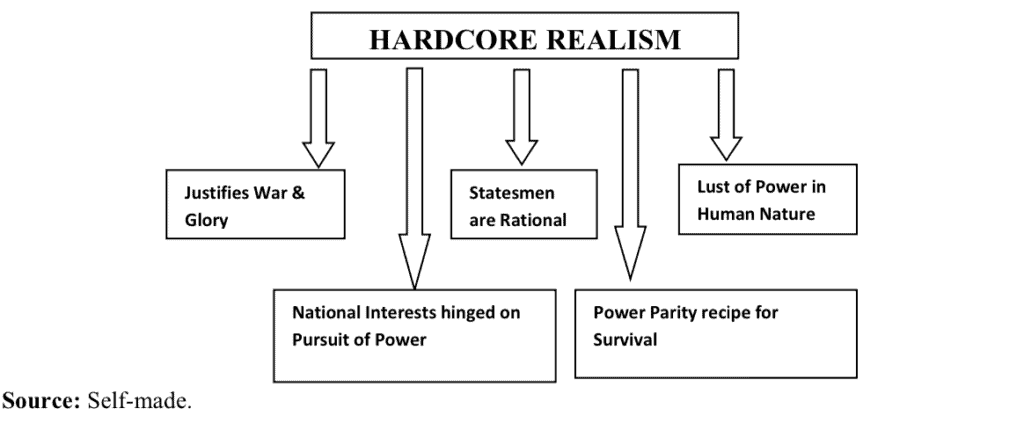“Your neighbor is your natural enemy and the neighbor’s neighbor is your friend”. (Chanakya Kautilya)
By Rana Danish Nisar
In ancient Indian History, Chandragupta (321-297 BC) has mammoth respect. Chandragupta is considered the founder of the Maurya Empire. He builds the largest empire which is likely commonly known as the Indian sub-continent.

In the North-west, Afghanistan, Seleuces| Nicator, Kabul, Kandahar, Taxila, Gandhara, and in west Gujarat, Junagadh, and also Malua in central India between Gujarat and Patariputra was the part of his empire. His empire was further enhanced by his grandson “Ashoka”. Interestingly, he was taught and counseled by his beloved “Chanakya” (375-283 BC) which is commonly known as Kautilya or Vishugupta in the historical literature. His services for Chandragupta and his state in the context of statecraft realism are highly acknowledgeable. His work named “Arthaashastra” is the renowned guideline for Indian strategic and defense scientists and policymakers and interestingly Indian strategic culture is highly dependent on “Arthaashastra”.
Recently, Indian looms towards its vicinities and strategic strategies “Look east” or “Act East” under the premier leadership of Respected Modi (Chandragupta) and Ajit Doval (Chanakya Kautilya) are directly or indirectly are the followers of Arthaashastra. The literal meaning of “Arthaashastra” is which means “Hegemony, Power maximization, military modernization, offensive power projection, aggressive usage of force and total annihilation of the adversaries”. Narendra Modi (1950-present) is the premier Indian prime minister from 2014 to the present and has aimed to provoke the “Made in India” slogan. Narendra Modi is a member of the Indian political party named “BJP” and an active activist of the Hindu extremist party “RSS”. “RSS” is the extremist Hindu organization with harsh and critical sentiments for Muslims along very renewed slogan “Mussalman ka ek hi sthan—Kabristan ya Pakistan” (Only one place for the Muslim—the graveyard, or Pakistan)”(1).
The renowned activist “RSS” named Balasahab Thakeeray said that “I wish that we would create Hindustan (India) only for Hindus”.(2) Beforehand Prime minister of India and head of New Delhi, Modi was the chief minister of Gujarat for a long time and timeline was 2001 to 2014. His beloved Indian National security advisor “Ajit Doval” as much as respect in the heart of Modi as like Chandragupta’s heart had a love for Kautilya”. Currently, Doval is giving his services as an Indian national security advisor and famous due to its offensive policies towards his neighborhoods, particularly in Pakistan. Before, Doval serve his services in Indian Intelligence Bureau. He is very famous owing to his doctrinal shifting of India from “defensive” to “defensive-offensive” or “Double Squeeze strategy”. Some experts argued that the mastermind of surgical strikes of India against Pakistan is Doval. Someone can say easily that the Modi-Doval nexus is the revival of history and history is restore from 340 BC (Chandragupta-Kautliya Nexus) to 2021 AD Modi-Doval nexus. Freshly, in recent times, beyond soft power, India is the damn biggest follower of hard power or hardcore realism, and the approach of India towards its vicinities i.e. Peaceful China, Pakistan, Sri-Lanka, Bangladesh and Myanmar is replica of Kautliya’s Arthaashastra.
Kashmir is the flashpoint of rivalry between India and Pakistan and recently, India has been abrogated the article of 370 and 35A in the contact of unilaterally which mirror its offensive nature and ambitions. Owing to abrogated article 370, the status of J&K as a disputed territory has been changed under the paradox resolutions of UNSC. Not only at the forum of UNGA and UNSC but at the regional level, Pakistan is the party of innocent Kashmiris and arise the slogan in the favor of Kashmir and self-determination but reciprocally Indian claim as Kashmir is its internal matter provoke the hatred sentiments between India and Pakistan.
The long-headed of violation of human rights in Kashmir is not acceptable for Pakistan. According to the UN charter, the people of Kashmir has right to live their life according to their own will and India has no any right to subjugate the innocent people in long curfew. All political leadership of Kashmir is behind bars and illegal detention of innocent civilians. The Kashmir valley is the world’s most militarized region and a nuclear flashpoint. By using its fable agenda, looms and developments, India wants to crush the resistance and resilience sentiments and spirit of Kashmiris in the shadow of his gun. Alongside with Kashmir dispute, India has a dispute with mostly all vicinities entities. It can be said simply that Indian foreign policy is the restoration of Chanakya’s thinking. India is seeing as well as itself as hegemony power of South Asia which is rejected by Pakistan.
Along with limited resources and tiny territory as compared to India, Pakistan challenge Indian hegemonic motives and it is the first time rare example that a tiny state with very limited resources challenges the major power state with the largest territory, rising economy, and largest nuclear and conventional force. Moreover, every state has its sovereignty, national interests, priorities, goals, and no other state has the right to intervene. In the South Asia context, the entities are considered India a threat to their security & sovereignty. India has long offensive history towards its vicinities. The supporting of Tamil tigers against Sri –Lanka, the limited war in 1962 against Peaceful China, the war against Pakistan 1965, supporting “Mukhti” movement against Pakistan and demise of east Pakistan in 1971, Black Canal issue with Nepal, domestic interference in Bhutan are the living example of Offensive India. in the context of Afghanistan, the land of Afghanistan is considered by India as its second homeland and use it against Pakistan. Doval argued that “we will fight in foreign soil with our advisories”.(3). With all differences,
Indian offensive behavior is a threat to the health of the region and sustainable peace. Currently, after the abrogation of 370 articles, the Modi-Doval nexus is promoting the chances of limited war which can change into nuclear war between two arch-rivals. Besides, India wants to undo Pakistan. The ongoing CPEC which is considered by strategic analysts as a game or destiny changer for Pakistan is considered by India as a threat to its hegemonic designs. The peaceful China presence in South Asia with soft power and an in-depth relationship with Pakistan is considered by India as the biggest obstacle to its offensive planning and achieving its goals. CPEC will bring economic prosperity for Pakistan alongside regional connectivity with other regional states i.e. Afghanistan, Iran, the Central Asian States which is not acceptable for India. India uses propaganda and looms against Pakistan aim to undo CPEC.
As a “status quo” state and ambassador of peace and defensive approach, Pakistan wants peace in the region and wants to settle down all conflicts with India but reciprocally Indian words are offensive for India. B.S Dhanooa argued that “There should be a surgical strike on Pakistan nuclear assets next time”(4). Pakistan always follows the defensive realism and Pakistan’s conventional as well as nuclear forces are just for its defense and Pakistan has no offensive motives. Most recently, Pakistan army chief of army staff Gen Qamar Javed Bajwa said that two states should “burry” the past and should go ahead for peace and better relationship(5). In the matter of Kashmir, India has no right to adopt individually the destiny of the people of J&K. there are three patrons in this issue, India, Pakistan, and J&K. So without any consent from the other two patrons, India can’t reconstruct any dogma which can revise the dubious prestige of the region. The world must realize and come to mediate on the issue to protect the mass killings, the genocide of innocent civilians by Indian armed forces and Hindu extremist groups.
The offensive authority drilled by the Indian army against the civilian population would supplementarily deteriorate the hanging condition of the region. The two nuclear power states may go for nuclear war if there will be no third-party mediation. It is the responsibility of the UNSC to put pressure on India aim to defend the lives of civilians. The foremost unprejudiced of UN is to maintain peace and security in the world. This hegemonic conduct of India may drag Pakistan into a war. It’s time for superpowers to play their role and bring the Indian government into the negotiation table.
Rana Danish Nisar The author is a PhD (International Relations) Student at the School of Politics and International Studies (SPIS). He holds Mphil in (International Relations), Masters in (Pakistan Studies), and Masters in (International Relations) degrees. He won acceptance Harvard Project for Asian and International Relations HPAIR (USA), 2017. His research interests are broadly in South Asian Affairs, South Asia Geo-Politics, India-Pakistan Relations, South Asian Nuclear Politics, US and South Asia, Indian Ocean, Security studies, South Asian developments studies.
(The views expressed in this article belong only to the author and do not necessarily reflect the editorial policy or views of World Geostrategic Insights).








